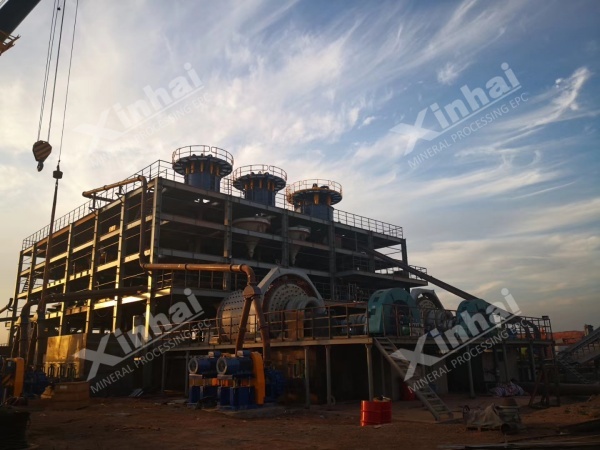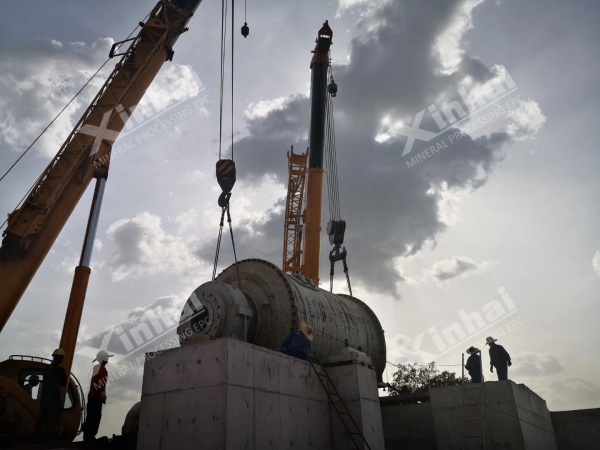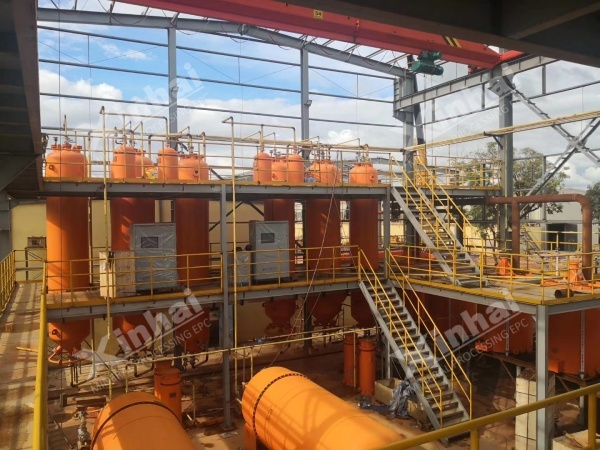If you want to know more information (such as product/process price, etc.), please contact us 24-hour telephone
The transformation and expansion of a concentrator is often far more complex than building a new one. This is due to challenges such as limited space, equipment compatibility, maintaining production continuity, and adapting to existing technical systems. With extensive experience in concentrator upgrades and expansions, Xinhai Mining Design Institute leverages modular design and dynamic construction planning to turn renovation challenges into opportunities for improving efficiency.
This article presents a case study of a gold mine expansion project in Guinea—a showcase of Xinhai’s technical strength and project execution capabilities.

The gold deposit is primarily composed of oxidized ore, 80% of which is powdery clay-type ore containing granular gold. The average gold grade is 1.0 g/t, with very few impurity elements. Gold is the only recoverable valuable element, and the ore is relatively easy to process.
The moisture content of the ore ranges from 25% to 30%, which, although favorable for beneficiation, can easily cause blockages during handling and processing.
Open-pit mining is employed. Due to the sandy and powdery nature of the ore, no blasting is required. The ore can be directly excavated and transported to the beneficiation plant using excavators, resulting in significantly lower mining costs.
Xinhai Mining provides comprehensive EPC (Engineering, Procurement, and Construction) services for this project, covering mine design, equipment procurement and installation, engineering construction, and project management.

The designed processing capacity of the first phase of the project was 4,000 t/d. Xinhai helped the client achieve the production target and reach full-capacity operation within just 10 months. Building on the success of the first phase, the client once again chose Xinhai for the second phase. As expected, Xinhai delivered a highly satisfactory result.
► Contract-to-commissioning cycle: Contract signed in February 2018, project commissioned in December 2018—only 10 months, including 2 months for equipment transportation and customs clearance.
► Core technical breakthroughs:
Developed an innovative feeding system to effectively resolve ore-blocking issues caused by clay-rich material;
Employed a reinforced gravity separation + cyanidation process, achieving a gold recovery rate of 90%;
Used an environmentally friendly leaching reagent to replace sodium cyanide, featuring lower toxicity, reduced cost, and comparable performance.

► Cost reduction and efficiency improvement in design:
(1)Given that the local price of concrete in Guinea is nearly five times higher than in China, Xinhai fully considered this in the design phase and adopted modular steel structures for all above-ground foundations of the processing plant (including ore bins). These pre-fabricated steel modules were manufactured in China and assembled on-site, enabling fast construction, reduced capital investment, and improved aesthetics.
(2)All equipment parameters were shared transparently with the client. Equipment procurement followed a flexible model: the client had the option of independent sourcing with technical support provided by Xinhai, ensuring both cost control and technical compliance.
► Construction period: Contract signed in March 2019, and the plant was successfully put into operation in November 2019—only 8 months, including time for equipment transportation and customs clearance.
► Capacity performance: The actual processing capacity after the expansion reached 6,600 t/d, exceeding the contractual target by 10%.
► Concurrent construction: During the expansion of the East Plant, construction also began on a 4.95 million tons/year cyanidation CIL plant in the West Plant area—further demonstrating the customer's strong trust in Xinhai Mining.
The completion schedule and core technologies of the two phases of the Guinea gold mine project have been introduced above. The following is a summary of the project's process flow:

As the raw ore is primarily fine clay with a small particle size and contains granular gold, a closed-circuit grinding–classification–gravity separation process was adopted.
(1)The ore transported by belt conveyor is first fed into an MQGg3245 ball mill for grinding. The mill discharge is then pumped to the jig separator for gravity concentration.
(2)The concentrate from the jig enters the shaking table for fine gold recovery, while the jig tailings are pumped to the first-stage cyclone cluster for classification.
(3)The overflow from the first cyclone flows to the second-stage cyclone for further classification and concentration. The underflow (settling product) from the second cyclone, along with part of its overflow, enters the leaching stage. The remaining overflow is sent to a thickener for pre-leaching concentration. Meanwhile, the underflow from the first cyclone is returned to the ball mill for regrinding.
The process adopts 10-stage leaching and 9-stage adsorption, followed by reverse carbon desorption.
Cyanide leaching is carried out in ten SJ11.00×11.50 leaching tanks for agitated leaching. The first tank serves as a pre-leaching tank, while the remaining nine tanks are used for leaching and adsorption. Counter-current adsorption with activated carbon is applied. After full adsorption, the gold-loaded carbon is separated from the slurry and transferred to the desorption electrolysis system.

The saturated gold-loaded carbon from the leaching system is sent to a 2000 kg high-temperature, high-pressure desorption electrolysis system for gold recovery. The resulting gold sludge from electrolysis contains high gold content. After impurity removal, it is directly sent to a high-frequency gold smelting furnace. The final product is doré gold (mixed gold).
The cyanidation tailings from the concentrator are pumped to the tailings storage facility (TSF) for settling. The clarified water is recycled back into production, achieving zero discharge of process wastewater.

Xinhai firmly believes that no two mines are exactly the same. Therefore, for every project—regardless of its scale—Xinhai insists on designing a customized beneficiation process instead of copying and applying processes from other projects.
This principle is especially critical for plant renovation and expansion projects, which require careful integration with the layout and equipment of the original plant. Such work demands extensive design expertise. Xinhai holds a Class B qualification in the metallurgical industry and has accumulated over 30 years of experience in mineral processing engineering.
In the Guinea gold mine project, the average construction period for both phases was ≤9 months, which is 30% shorter than the industry average.
Thanks to pre-assembled steel structure technology, overseas construction costs were reduced by up to 50%, greatly accelerating project delivery and early production.
The global push for green mining is growing stronger every day. Xinhai has always regarded ecological responsibility as a core mission. In the Guinea project, Xinhai replaced traditional sodium cyanide with low-toxicity leaching reagents, achieving excellent metallurgical performance while improving environmental protection and reducing costs.
Likewise, in the Oceania gold mine project, Xinhai tailored the concentrator layout based on the geographic location of the ore body, and took effective measures to preserve nearby rivers and the surrounding ecological environment—earning high praise from local communities.
In the Guinea project, Xinhai provided complete technical specifications and supported the client in independent equipment procurement, with no bundled sales.
During the first-phase design, Xinhai respected customer input and reserved space for future upgrades. As a result, the second-phase expansion not only accelerated production start-up, but also exceeded output expectations by 10% (6,600 t/d), receiving full recognition from the client.

Conclusion
The Guinea gold mine project reaffirmed a key insight for Xinhai: successful plant expansion is not just about increasing production—it is a comprehensive test of technical adaptability, engineering coordination, and deep understanding of customer needs.
As a Chinese enterprise serving the global mining sector, Xinhai always places customer needs at the core and integrates the concept of green mining into every stage of service.
Choosing Xinhai means choosing three key guarantees:
Fast commissioning
High-efficiency production
Environmental compliance
If you are planning a plant renovation or capacity expansion, feel free to contact us!